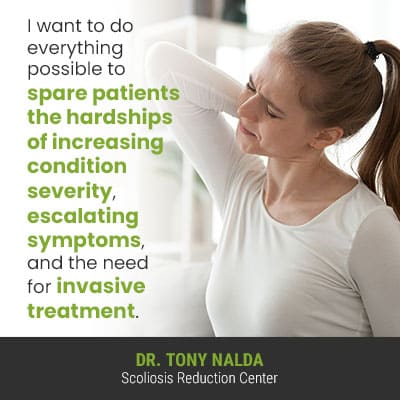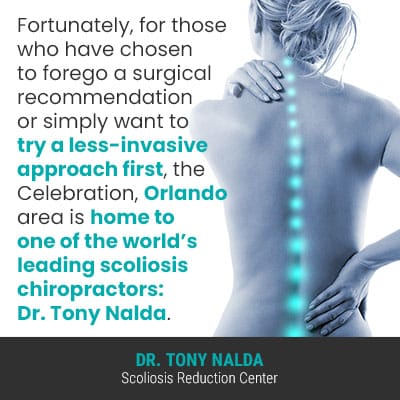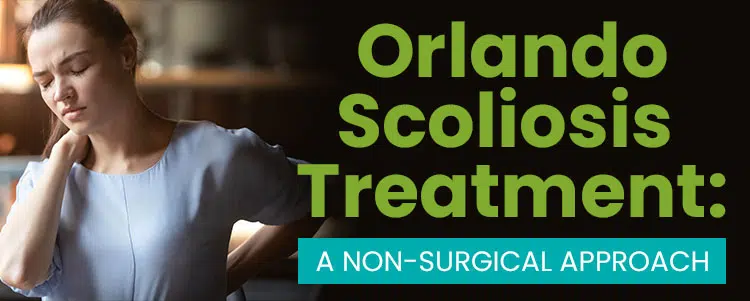There are two main approaches to treating scoliosis, each offering patients a different potential outcome; in fact, the most important decision facing those recently diagnosed is how to treat it moving forward. Continue reading to learn the important differences between a traditional surgical approach and a conservative non-surgical approach.
Florida residents in search of Orlando scoliosis treatment don’t have far to travel. Dr. Tony Nalda, of the Scoliosis Reduction Center®, provides proactive non-surgical treatment for residents of the Orlando area, while others traverse great distances for his unique skill-set and experience.
Choosing a scoliosis treatment provider is key to treatment success, so before getting to the specifics of Orlando scoliosis treatment, let’s talk generally about scoliosis and the two main treatment approaches.
Looking for another city in Florida for scoliosis treatment?
- Daytona Beach Area Scoliosis Treatment
- Sarasota Area Scoliosis Treatment
- Fort Lauderdale Scoliosis Treatment
- Tallahassee Scoliosis Treatment
- Tampa Scoliosis Treatment
- Miami Scoliosis Treatment
- Jacksonville Scoliosis Treatment
- Pensacola Area Scoliosis Treatment
What is Scoliosis?
Scoliosis is a structural spinal condition that involves the development of an unnatural sideways curve with rotation, making it a 3-dimensional condition. The spine doesn’t just bend unnaturally to the side but also twists from front to back, back to front.
Two important characteristics of scoliosis to understand, particularly for those who have been recently diagnosed, is that scoliosis is both highly-variable and progressive.
Scoliosis develops across a wide severity spectrum: mild to moderate and severe to very severe.
Condition severity is a classification point that’s determined by a measurement known as Cobb angle, and this involves drawing lines from the tops and bottoms of the curve’s most-tilted vertebrae (at its apex), and the resulting angle is expressed in degrees:
- Mild scoliosis: Cobb angle measurement of between 10 and 25 degrees
- Moderate scoliosis: Cobb angle measurement of between 25 and 40 degrees
- Severe scoliosis: Cobb angle measurement of 40+ degrees
- Very-severe scoliosis: Cobb angle measurement of 80+ degrees
Generally speaking, the higher the Cobb angle, the more overt condition symptoms tend to be, and this can include both postural deviation and pain, although the condition is more commonly painful for adults, than children and adolescents.

The wide range in Cobb angle measurements shows how variable the condition is. In addition, it’s progressive: meaning it’s in the very nature of scoliosis to get worse over time, particularly if left untreated or not treated proactively.
Because scoliosis is progressive, where scoliosis is at the time of diagnosis is not indicative of where it will stay.
A person diagnosed with mild scoliosis can still progress to moderate, severe, or very severe at different progressive rates, which is why being proactive with treatment is so important.
So now that we’ve discussed the condition generally, including some of its defining features, let’s move on to exploring the two main scoliosis treatment approaches: traditional and conservative.
Traditional Scoliosis Treatment: Surgical Approach
The surgical approach to scoliosis treatment is known as the traditional approach, and its main response to a diagnosis of mild scoliosis is to watch and wait: watch and wait for further progression.
While some people progress slowly over time, others progress quickly; the main trigger for progression is growth and development, so children and adolescents, because of the stage of growth they are in, are at risk for rapid-phase progression.
As the traditional approach tends to re-assess adolescents for progression at periodic intervals every 3, 6, and even 12 months (intervals depend on the treatment provider). In between assessments, an adolescent patient can have a significant growth spurt and experience equally-significant progression, meaning the condition is becoming more complex to treat and pushing patients towards more-invasive treatment, like spinal fusion.
In fact, the only form of treatment applied by the traditional approach prior to surgery is traditional bracing, often prescribed while in the moderate or severe level, but traditional bracing is limited in its efficacy for many reasons. The main one being that it only addresses the condition as 2-dimensional rather than 3-dimensional.
Once a patient progresses past the 40+ degree mark and enters into the severe or very-severe classification, they have crossed the surgical-level threshold and become a candidate for surgery.
The issue I have with this is that had proactive treatment been applied earlier in the condition’s progressive line, that patient might not have crossed that surgical threshold and could have avoided the hardships associated with increasing condition severity and invasive spinal fusion.
Fortunately, for those who have chosen to forego a surgical recommendation or simply want to try a less-invasive approach first, the Celebration, Orlando area is home to one of the world’s leading scoliosis chiropractors: Dr. Tony Nalda.
Conservative Scoliosis Treatment: Non-Surgical Approach
For those in need of Orlando Scoliosis Treatment, look no further than the Scoliosis Reduction Center® located in Celebration, Orlando, Fl.
While many travel from afar for the benefit of Dr. Nalda’s modern and dynamic non-surgical scoliosis treatment approach, residents of Orlando have the perk of proximity.

A conservative approach values proactively responding to diagnoses with treatment initiated as close to the time of diagnosis as possible. There’s a sense of immediacy for me because as a progression condition, scoliosis isn’t static, and unless efforts are made to counteract the condition’s progressive nature, every case is virtually guaranteed to get worse at some point.
I want to do everything possible to spare patients the hardships of increasing condition severity, escalating symptoms, and the need for invasive treatment.
As I’m trained and certified in multiple condition-specific treatment modalities, patients of the Center have the advantage of accessing multiple forms of treatment, each with its own unique benefit, under one roof.
So even for those who have to travel from outside Orlando, Florida, to access my practice, it can be worth the journey to undergo treatment that strives to preserve as much natural spinal function as possible, not to mention helping patients avoid costly and invasive surgical treatment.
While there are no treatment guarantees, by combining chiropractic care, in-office therapy, custom-prescribed home exercises, and corrective bracing, I can help patients achieve a curvature reduction on a structural level.
Once I have impacted a condition structurally, through a variety of therapies and scoliosis-specific exercises (SSEs), I help patients work towards increasing core strength, so the spine is optimally supported and stabilized by its surrounding muscles.
In addition, certain SSEs, when combined with other forms of effective treatment, can activate areas of the brain for better brain-body communication, postural remodeling, and more natural body positioning.
Conclusion
When it comes to treating scoliosis, patients have to ask themselves what type of outcome they want.
For those who are looking to preserve as much natural spinal function as possible, meaning flexibility and range of motion, a conservative non-surgical treatment approach is the best chance of achieving that outcome.
For those in search of Orlando scoliosis treatment, reach out to us here so we can help put patients on the path to proactive treatment that’s customized to suit the specifics of each patient and their condition type.




